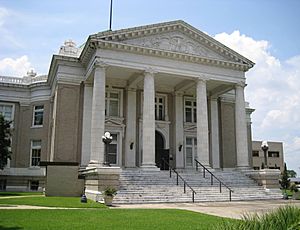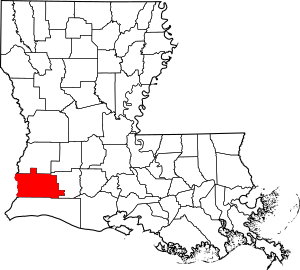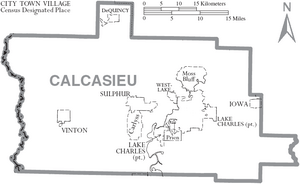Calcasieu Parish, Louisiana facts for kids
Quick facts for kids
Calcasieu Parish, Louisiana
|
|
|---|---|
| Parish of Calcasieu | |

Calcasieu Parish District Courthouse
|
|

Location within the U.S. state of Louisiana
|
|

Louisiana's location within the U.S.
|
|
| Country | |
| State | |
| Region | Acadiana |
| Founded | March 24, 1840 |
| Named for | Atakapa word for crying eagle |
| Parish seat (and largest city) | Lake Charles |
| Area | |
| • Total | 2,830 km2 (1,094 sq mi) |
| • Land | 2,760 km2 (1,064 sq mi) |
| • Water | 80 km2 (31 sq mi) |
| • percentage | 7 km2 (2.8 sq mi) |
| Population
(2020)
|
|
| • Total | 216,785 |
| • Estimate
(2019)
|
203,436 |
| • Rank | LA: 7th |
| • Density | 76.51/km2 (198.16/sq mi) |
| Time zone | UTC-6 (CST) |
| • Summer (DST) | UTC-5 (CDT) |
| Congressional district | 3rd |
Calcasieu Parish ( French: Paroisse de Calcasieu) is a parish located on the southwestern border of the U.S. state of Louisiana. As of the 2020 census, the population was 216,785. The parish seat is Lake Charles.
Calcasieu Parish is part of the Lake Charles, LA Metropolitan Statistical Area with a population of 194,138. It is also located near the Beaumont–Port Arthur (Texas), Lafayette, and Alexandria metropolitan areas.
Calcasieu Parish was created March 24, 1840, from the parish of Saint Landry, one of the original nineteen civil parishes established by the Louisiana Legislature in 1807 after the United States acquired the territory in the Louisiana Purchase of 1803. The original parish seat was Comasaque Bluff, a settlement east of the river and later called Marsh Bayou Bluff. On December 8, 1840, it was renamed as Marion, Louisiana.
In 1852 Jacob Ryan, a local planter and businessman, donated land and offered to move the courthouse in order to have the parish seat moved to Lake Charles. As the population in this area grew over the years, the original Calcasieu Parish has since been divided into five smaller parishes. The original area of Calcasieu Parish is called Imperial Calcasieu.
Contents
History
The name Calcasieu [p] comes from the Atakapan word, "quelqueshue" in a French transliteration, meaning "crying eagle." It was the name of an Atakapa chief, which French colonists applied to the local river, the Calcasieu River. When the Spanish controlled this area, they referred to this river as the Rio Hondo River (Rio Stondo or "Deep River"). The Americans adopted the French name in turn for the parish.
Early history
The early history of the parish dates to the period of the Spanish occupation of Louisiana, after France had ceded this territory following its defeat by Great Britain in the Seven Years War. In 1797, Jose M. Mora was granted a large tract of land between the Rio Hondo (now Calcasieu River) and the Sabine River, known for years as the "Neutral Strip". The area became a refuge for outlaws and filibusters from Carolina, Georgia, and Mississippi of the United States, which had recently gained independence from Great Britain.
The territory was disputed for years between Spain and the United States after France had ceded Louisiana to the American government as part of the Louisiana Purchase of 1803. It was definitively acquired by the United States from Spain with the Adams-Onis Treaty in 1819. The treaty was formally ratified on February 22, 1821. By an act of Congress, approved on March 3, 1823, this strip of land was attached to the district of the Louisiana Territory south of the Red River.
Early settlers to the area included the Ryan, Perkin, LeBleu, Deviers, and Henderson families. Acadian settlers, from the eastern parishes of Louisiana, also migrated to this area. Of French descent and exiled from Acadia, many of these refugees had settled in Louisiana. The parish had a diverse ethnic mix of French and Spanish Creoles, Acadians, Anglo-Americans, and Indians.
When "Imperial Calcasieu Parish" was created in 1840 from the Parish of Saint Landry, it comprised a large area. With the growth of population in the area, this was subsequently divided into five parishes. On August 24, 1840, six men met to organize as representatives for six wards that later became five parishes. The meeting was held in the house of Arsene LeBleu near present-day Chloe. The first jury men were David Simmons, Alexander Hébert, Michel Pithon, Henry Moss, Rees Perkins, and Thomas M. Williams. Their first order of business was to elect officers, appoint a parish clerk, and settle on simple parliamentary rules that would enable the president to keep the meetings orderly and progressive. The jury adopted all of the laws then in force in Saint Landry Parish. They appointed a parish constable, a parish treasurer, two parish assessors, and an operator of the ferry at Buchanan's crossing. The assessors were given two months to assess all of the property in the parish and a salary of $90.
On September 14, 1840, a survey was authorized of land known then as Marsh Bayou Bluff in order to establish a seat of justice (parish seat) and construct a courthouse and jail. On December 8, 1840 the jury chose to rename this community as [Marion. In 1843, the Legislature authorized a vote to move the parish seat.
Finally in 1852 Jacob Ryan was successful in having the parish seat relocated from Marion to the east bank of Lake Charles. This parish seat was incorporated in 1857 as the town of Charleston; it was reincorporated in 1868 as Lake Charles. It is located about six miles (10 km) from Marion, now known as Old Town. The name Lake Charles commemorates one of the first European settlers, Charles Sallier, an Italian who acquired land in this area at the beginning of the 19th century.
In 1870 Cameron Parish was taken from the south portion of Imperial Calcasieu. it was one of several parishes organized during the Reconstruction era by the Republican-dominated legislature, in an effort to build Republican strength. Because areas had been developed as cotton plantations, Calcasieu Parish had numerous slaves. After emancipation, most joined the Republican Party. The area set aside for Cameron Parish had a majority-white population. In the late 1870s, white Democrats regained control of the state legislature through fraud and intimidation. At the turn of the century, they disenfranchised most blacks, then passed racial segregation and other Jim Crow laws.
In 1912 Calcasieu Parish still comprised an area of more than 3,600 square miles (9,300 km2), and it was the largest parish in the state. For this reason it is sometimes called "Imperial Calcasieu". In 1912, the three parishes of Allen, Beauregard, and Jefferson Davis, with a total area of approximately 2,548 square miles (6,600 km2), were formed from the Parish of Calcasieu. These were the last parishes organized in Louisiana. These jurisdictional changes are believed to account for the marked decrease in population of Calcasieu Parish between 1910 and 1920, as seen in the censuses for those years.
Geography
According to the U.S. Census Bureau, the parish has a total area of 1,094 square miles (2,830 km2), of which 1,064 square miles (2,760 km2) is land and 31 square miles (80 km2) (2.8%) is water.
Major highways
 Interstate 10
Interstate 10 Interstate 210
Interstate 210 U.S. Highway 90
U.S. Highway 90 U.S. Highway 165
U.S. Highway 165 U.S. Highway 171
U.S. Highway 171 Louisiana Highway 12
Louisiana Highway 12 Louisiana Highway 14
Louisiana Highway 14 Louisiana Highway 27
Louisiana Highway 27
Adjacent counties and parishes
- Beauregard Parish (north)
- Jefferson Davis Parish (east)
- Cameron Parish (south)
- Orange County, Texas (west)
- Newton County, Texas (northwest)
Major waterways
- Lake Charles
- Calcasieu River
- Intracoastal Canal
- Ouiski Chitto Creek
- English Bayou
- West Fork
- Calcasieu Lake
Demographics
| Historical population | |||
|---|---|---|---|
| Census | Pop. | %± | |
| 1840 | 2,057 | — | |
| 1850 | 3,914 | 90.3% | |
| 1860 | 5,928 | 51.5% | |
| 1870 | 6,733 | 13.6% | |
| 1880 | 12,484 | 85.4% | |
| 1890 | 20,176 | 61.6% | |
| 1900 | 30,428 | 50.8% | |
| 1910 | 62,767 | 106.3% | |
| 1920 | 32,807 | −47.7% | |
| 1930 | 41,963 | 27.9% | |
| 1940 | 56,506 | 34.7% | |
| 1950 | 89,635 | 58.6% | |
| 1960 | 145,475 | 62.3% | |
| 1970 | 145,415 | 0.0% | |
| 1980 | 167,223 | 15.0% | |
| 1990 | 168,134 | 0.5% | |
| 2000 | 183,577 | 9.2% | |
| 2010 | 192,768 | 5.0% | |
| 2020 | 216,785 | 12.5% | |
| U.S. Decennial Census 1790-1960 1900-1990 1990-2000 2010-2019 |
|||
2020 census
| Race | Number | Percentage |
|---|---|---|
| White (non-Hispanic) | 137,110 | 63.25% |
| Black or African American (non-Hispanic) | 54,825 | 25.29% |
| Native American | 902 | 0.42% |
| Asian | 3,797 | 1.75% |
| Pacific Islander | 137 | 0.06% |
| Other/Mixed | 8,630 | 3.98% |
| Hispanic or Latino | 11,384 | 5.25% |
As of the 2020 United States census, there were 216,785 people, 77,232 households, and 53,308 families residing in the parish.
2010 census
As of the census of 2010, there were 192,768 people, 73,996 households, and 50,490 families residing in the parish. The population density was 176 people per square mile (66/km2). There were 75,995 housing units at an average density of 71 per square mile (27/km2). 70.8% of the population were White, 24.9% Black or African American, 1.1% Asian, 0.5% Native American, 0.9% of some other race and 1.9% of two or more races. 2.6% were Hispanic or Latino (of any race). 24.9% were of French, French Canadian or Cajun, 8.4% American, 6.2% Irish, 6.2% English and 6.1% German ancestry. 5.98% reported speaking French or Cajun French at home, while 1.56% speak Spanish.[1]
There were 73,996 households, out of which 35.60% had children under the age of 18 living with them, 52.60% were married couples living together, 14.70% had a female householder with no husband present, and 28.50% were non-families. 24.00% of all households were made up of individuals, and 8.90% had someone living alone who was 65 years of age or older. The average household size was 2.61 and the average family size was 3.11.
In the parish the population was spread out, with 27.40% under the age of 18, 10.30% from 18 to 24, 28.70% from 25 to 44, 21.80% from 45 to 64, and 11.90% who were 65 years of age or older. The median age was 34 years. For every 100 females there were 94.80 males. For every 100 females age 18 and over, there were 91.30 males.
The median income for a household in the parish was $35,372, and the median income for a family was $41,903. Males had a median income of $36,569 versus $21,390 for females. The per capita income for the parish was $17,710. About 12.80% of families and 15.40% of the population were below the poverty line, including 19.90% of those under age 18 and 14.20% of those age 65 or over.
National Guard
Elements of the 256th IBCT and the 139TH RSG (Regional Support Group) are based in Lake Charles, Louisiana. The 256th IBCT deployed to Iraq twice, 2004-5 and 2010. De Quincy, Louisiana is the home of both the HHC 3-156TH Infantry Battalion and F Company of the 199th Forward Support Battalion. These units deployed to Iraq with the 256TH IBCT.
Communities
Cities
- DeQuincy
- Lake Charles (parish seat)
- Sulphur
- Westlake
Towns
Census-designated places
Unincorporated community
Education
Public schools are operated by the Calcasieu Parish School Board.
It is in the service area of Sowela Technical Community College.
Notable people
- Mark Abraham (born 1953), politician elected in 2015 as state representative for Calcasieu Parish, was sworn in January 2016.
- Eston Arledge (1917-1941), Vinton native and Purple Heart recipient killed-in-action on board the USS Arizona at Pearl Harbor while serving in the US Navy.
- Ken Bahnsen (born 1930), former NFL fullback and collegiate football and tennis coach. Member of the Athletic Hall of Fame at the University of North Texas.
- Terry Burrows (Born 1968), former Major League Baseball pitcher and head baseball coach at McNeese State University.
- A.C. Clemons (1921–1992), Democratic politician elected to the Louisiana State Senate. He switched parties and became the first declared Republican member of the state senate since the Reconstruction era. His district included part of Calcasieu Parish.
- Casey Daigle (born 1981), former Major League Baseball pitcher. Husband of American Olympic gold medalist Jennie Finch.
- Mike Danahay, Democratic state representative for Calcasieu Parish since 2008; sales representative in Lake Charles; formerly resided in Sulphur and Vinton
- Alvin Dark (1922-2014) former Major League Baseball player and manager
- Michael E. DeBakey (1908-2008), heart surgeon; first person to successfully implant an artificial heart (1963); member of the Health Care Hall of Fame; recipient of the United Nations Lifetime Achievement Award, the Presidential Medal of Freedom with Distinction, and the National Medal of Science; originator of the M.A.S.H. unit concept.
- Sean Patrick Flanery (born 1965), is an American actor, author and martial artist.
- Dan Flavin (born 1957), Republican former member of the Louisiana House of Representatives from Calcasieu and Cameron parishes. He operates a real estate office in Lake Charles.
- 1LT. Douglas B. Fournet (1943-1968), Medal of Honor recipient killed-in-action in the Vietnam War.
- A. B. Franklin (born 1948), an African-American businessman and Democratic politician from Lake Charles who has served as a member of the Louisiana House of Representatives for Calcasieu Parish since 2008.
- Lether Frazar (1904–1960), university administrator, was the fourth president of McNeese State University, the second president of the University of Louisiana at Lafayette, and a former member of the Louisiana House of Representatives.
- Gilbert Franklin Hennigan (1883-1960), served in the Louisiana Senate from Allen, Beauregard, Calcasieu, Cameron, and Jeff Davis parishes from 1944 to 1956. He was born in Meadows in Calcasieu Parish and also lived in Beauregard Parish.
- Harry Hollins, state representative for Calcasieu Parish from 1964 to 1980.
- Ronnie Johns (born 1949), a State Farm Insurance agency owner in Sulphur who served in the Louisiana House of Representatives from 1996 to 2008; he was unopposed for the state senator from District 27 in 2011.
- Charlie Joiner (born 1947), former NFL wide receiver and member of the Pro Football Hall of Fame.
- John Sebastian Jones (1872-1959), first dean of Southern University. Father of Ralph Waldo Emerson Jones.
- Ralph Waldo Emerson Jones (1905-1982), former football and baseball coach and later president at Grambling State University.
- Robert G. "Bob" Jones (born 1939), a Lake Charles stockbroker, served in both houses of the Louisiana legislature between 1968 and 1976. He later switched to the Republican Party after running unsuccessfully in the 1975 gubernatorial primary.
- Sam Houston Jones (1897–1978), born and raised in nearby Beauregard Parish, he practiced law in Lake Charles for years prior to his election as governor in 1940.
- Eddie Kennison (born 1973), former LSU and NFL and wide receiver. Member of Louisiana Sports Hall of Fame.
- Bobby Kimball (born 1947), former lead singer and original member of the band Toto.
- Tony Kushner (born 1956), Pulitzer Prize-winning playwright
- Alvan Lafargue (1883–1962), a physician who practiced for 50 years primarily in Calcasieu Parish. He was the mayor of Sulphur from 1926 to 1932.
- Conway LeBleu (1918-2007), a Lake Charles native who represented Cameron and part of Calcasieu parishes in the Louisiana House from 1964 to 1988.
- Zachary Levi (born 1980), American actor, comedian, and singer.
- Coleman Lindsey (1892–1968), born in a part of Calcasieu Parish that is now the Dry Creek community of Allen Parish. He was a state senator from Bossier and Webster parishes, lieutenant governor from 1939 to 1940, and a state court district judge in East Baton Rouge Parish from 1950 until his death.
- Nate Livings (born 1982), former NFL offensive lineman.
- Margaret Lowenthal (1929-2003), the first woman to represent Calcasieu Parish in the Louisiana House, with service from 1980 to 1988.
- Janice Lynde (born 1948), American actress and original cast member of The Young and the Restless.
- Ted Lyons (1900-1986), former Major League Baseball pitcher and manager. 1955 inductee to the Baseball Hall of Fame.
- Tommy Mason (1939-2015), former professional American Football player in the NFL. First overall pick of the 1961 NFL Draft.
- Dak Prescott (born 1993), current quarterback for the Dallas Cowboys of the NFL.
- Trey Quinn (born 1995), professional athlete for the Jacksonville Jaguars of the NFL.
- Rupert Richardson (1930-2008), African-American civil rights activist and civil rights leader who served as president of the National Association for the Advancement of Colored People (NAACP) from 1992 to 1995.
- Guy Sockrider (1921-2011), businessman and state senator from Jennings and Lake Charles from 1948 to 1964
- Victor T. "Vic" Stelly (1941-2020), former Republican state representative from Calcasieu Parish and author of the Stelly Plan
- Dennis Stine, state representative (1987-1988) and state commissioner of administration (1988-1992), Lake Charles timber businessman reared in Sulphur
- Tim Stine, state representative (1988-1996) and member of the Sulphur City Council (1986-1988), timber businessman and brother of Dennis Stine
- Martin Waldron (1925–1981), winner of the 1964 Pulitzer Prize for reporting on unchecked spending on the Florida Turnpike.
See also
 In Spanish: Parroquia de Calcasieu para niños
In Spanish: Parroquia de Calcasieu para niños


